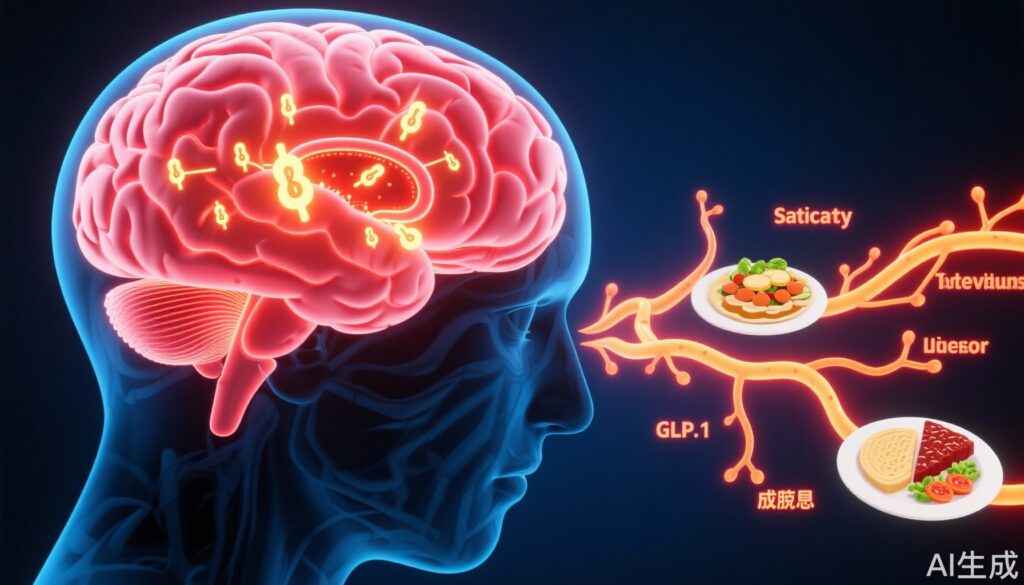Introduction: The Temptation of Hedonic Eating
Have you ever felt completely full but found yourself irresistibly drawn to a tempting dessert or the smell of fried chicken wafting through the air? This urge to eat beyond physical hunger to satisfy the taste buds is termed “hedonic eating.” It operates like a hidden switch in our brain, quietly overriding the body’s natural stop signals to continue eating delicious foods.
The question of what neurobiological forces drive us to indulge despite physiological satiety has intrigued scientists for years. A groundbreaking study published in Science on March 28, 2025, titled “Hedonic eating is controlled by dopamine neurons that oppose GLP-1R satiety,” sheds new light on the neural mechanisms behind this phenomenon. It identifies the ventral tegmental area (VTA)—a key brain region—and its dopamine-releasing neurons as pivotal players in hedonic feeding behavior.
Dopamine and the VTA: The Brain’s Reward Center
The human brain is a complex organ composed of billions of neurons intricately connected to regulate bodily functions, including appetite and feeding behaviors. Among these, the ventral tegmental area (VTA), located in the midbrain, is widely recognized as a crucial reward center.
The VTA is rich in dopamine, a neurotransmitter intimately linked to reward, motivation, and learning. When we experience pleasure—whether from savoring tasty food, receiving praise, or accomplishing a goal—dopamine neurons in this area become active, releasing dopamine and generating feelings of satisfaction and happiness. This positive reinforcement encourages repetition of these behaviors.
Highly palatable foods, such as sweets and fried items, strongly activate these dopamine neurons, triggering intense dopamine release. This surge produces a powerful sensation of pleasure and satisfaction, fueling a strong desire to seek and consume these foods. Accordingly, VTA dopamine neurons are considered the key drivers of the craving and intake of highly palatable foods, thus playing a core role in hedonic eating.
A Tug of War: The Brain’s Struggle Between Pleasure and Fullness
Normally, our body signals when enough energy has been consumed through complex physiological processes, including hormone release that signals satiety to the brain. One vital hormone involved is glucagon-like peptide-1 (GLP-1), secreted by intestinal L-cells. GLP-1 not only increases insulin secretion to regulate blood glucose but also travels via the bloodstream to the brain to stimulate neurons that induce feelings of fullness, reduce appetite, and slow gastric emptying.
The receptor for GLP-1 (GLP-1R) mediates these effects by activating downstream signaling pathways that culminate in the brain’s “I’m full” messages, curbing further food intake.
However, when exposed to highly palatable foods, the body’s satiety signals often seem insufficient. Despite physiological fullness, the allure of tasty food can overpower these signals, leading to continued eating. This suggests that mechanisms exist which suppress GLP-1R-mediated satiety signals during hedonic eating. Researchers hypothesized that activation of VTA dopamine neurons could inhibit GLP-1R pathways, diminishing satiety sensations and promoting excess intake despite fullness.
Experimental Evidence: Dopamine Neurons Lead the Charge
To rigorously test this hypothesis, researchers conducted sophisticated animal experiments involving mice. They employed cutting-edge neuroscience tools such as optogenetics and chemogenetics to manipulate the activity of specific neurons—in this case, the VTA dopamine neurons—and observe impacts on feeding behaviors.
The study observed a substantial increase in VTA dopamine neuron activity when mice encountered high-palatable food rich in fats and sugars. Artificial activation of these neurons via optogenetics in mice that were already physiologically full led to an abnormal increase in consumption of tasty food, surpassing normal intake levels. Conversely, chemogenetic suppression of these neurons resulted in significant reduction in consumption, even when palatable food was available.
These compelling findings firmly establish VTA dopamine neurons as dominant regulators driving hedonic feeding.
GLP-1 Receptors: The Faithful Guardians of Fullness
The study didn’t stop there—it also delved into how GLP-1 receptors interact with dopamine neurons. Detailed neural analysis revealed that some VTA neurons simultaneously express dopamine receptors and GLP-1 receptors. This co-expression suggests a direct interaction site where dopamine and GLP-1 signals may compete or modulate feeding behavior.
Further pharmacological investigation showed that blocking GLP-1R signaling in the brain resulted in mice maintaining high intake of palatable food despite being full, mirroring effects seen with dopamine neuron activation. This strongly indicates that dopamine neuronal activity can suppress GLP-1R-mediated satiety signals.
The Neurobiological “Silent War” Between Dopamine and GLP-1
To visualize this interaction intricately, researchers utilized advanced neuroimaging techniques like two-photon microscopy, observing live neuronal activity in real-time during palatable food consumption. They found that heightened dopamine signals reduced GLP-1 responsiveness of neurons, essentially lowering their sensitivity to satiety cues.
Moreover, employing retrograde tracing—a method to map neural connections—they discovered that VTA dopamine neurons send projections to key brain areas rich in GLP-1 receptor expression, such as the hypothalamus. When these dopamine neurons were activated, they released neurotransmitters that directly inhibited the activity of GLP-1R-expressing neurons, weakening the transmission of satiety signals.
In summary, the study paints a picture of a concealed neurochemical battleground: dopamine release enhances reward signals driving food craving while simultaneously dampening fullness signals mediated by GLP-1R. When delicious food is present, dopamine’s power often triumphs, overriding the brain’s own “stop eating” alerts, making it difficult to resist indulgence.
A Patient Story: Mark’s Struggle with Hedonic Eating
Consider Mark, a 42-year-old software engineer. Despite maintaining a balanced diet and exercising regularly, Mark often finds himself snacking excessively on sweets and fried foods after dinner, long after he feels physically full. This behavior has gradually contributed to weight gain and frustration.
Understanding the brain mechanisms behind hedonic eating, like the role of dopamine overcoming satiety signals, can help Mark and his healthcare providers target interventions more effectively. For example, medication that enhances GLP-1 signaling or behavioral therapies focusing on reducing the reward response to palatable food might offer promising avenues for control.
Implications for Obesity and Metabolic Disease Interventions
This pioneering research opens new frontiers in tackling the global rise of obesity and metabolic disorders related to overeating. Therapeutic strategies could focus on:
1. Modulating VTA dopamine neuron activity to reduce excessive reward-driven eating.
2. Developing more potent GLP-1 receptor agonists that strengthen satiety signaling despite hedonic triggers.
3. Combining pharmacological approaches with behavioral interventions aimed at reducing exposure or response to palatable food cues.
However, translating these findings from animal models to clinical treatments demands careful, controlled human studies to ensure safety and efficacy.
Conclusion
The discovery of the interaction between dopamine neurons in the VTA and GLP-1 receptor-mediated satiety marks a significant leap in our understanding of hedonic eating. It reveals how pleasure-driven eating behaviors can dominate over physiological signals to stop eating, illuminating a potential neural mechanism behind overeating and obesity.
Future research inspired by these findings may pave the way for innovative therapies that balance the brain’s reward and satiety systems, helping individuals maintain healthy eating habits and combat obesity more effectively.
References
Zhu Z, Gong R, Rodriguez V, Quach KT, Chen X, Sternson SM. Hedonic eating is controlled by dopamine neurons that oppose GLP-1R satiety. Science. 2025 Mar 28;387(6741):eadt0773. doi: 10.1126/science.adt0773. Epub 2025 Mar 28. PMID: 40146831.



